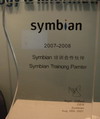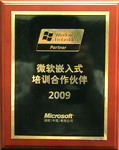| |
|
| |
| |
 班级规模及环境--热线:4008699035 手机:15921673576( 微信同号) 班级规模及环境--热线:4008699035 手机:15921673576( 微信同号) |
| |
每期人数限3到5人。 |
| |
 上课时间和地点 上课时间和地点 |
| |
上课地点:【上海】:同济大学(沪西)/新城金郡商务楼(11号线白银路站) 【深圳分部】:电影大厦(地铁一号线大剧院站)/深圳大学成教院 【北京分部】:北京中山学院/福鑫大楼 【南京分部】:金港大厦(和燕路) 【武汉分部】:佳源大厦(高新二路) 【成都分部】:领馆区1号(中和大道) 【沈阳分部】:沈阳理工大学/六宅臻品 【郑州分部】:郑州大学/锦华大厦 【石家庄分部】:河北科技大学/瑞景大厦 【广州分部】:广粮大厦 【西安分部】:协同大厦
最近开课时间(周末班/连续班/晚班):2020年6月15日 |
| |
 实验设备 实验设备 |
| |
☆资深工程师授课
☆注重质量
☆边讲边练
☆合格学员免费推荐工作
★实验设备请点击这儿查看★ |
| |
 质量保障 质量保障 |
| |
1、培训过程中,如有部分内容理解不透或消化不好,可免费在以后培训班中重听;
2、培训结束后,授课老师留给学员联系方式,保障培训效果,免费提供课后技术支持。
3、培训合格学员可享受免费推荐就业机会。 |
| |
课程大纲 |
| |
|
| |
- 课程介绍:
This instructor-led course teaches IT professionals how to plan, design, deploy, configure, and administer a Microsoft Lync Server 2013 solution. The course emphasizes Lync Server 2013 Enterprise Unified Communications features with particular emphasis on coexisting with and migrating from legacy communication services. The labs in this course create a solution that includes IM and Presence, Conferencing, and Persistent Chat. This course helps the student prepare for Exam 70-336.
-
课程大纲:
Module 1: Architecture and design approach for Microsoft Lync Server 2013
This module will help you to plan and design a Lync Server 2013 implementation that meets organizational and user needs. This module equips you with knowledge about Lync Server 2013 key features and functionality and introduces you to Microsoft Solutions Framework (MSF), which recommends a structured approach to project management and execution.
Lessons
•Overview of Lync Server 2013 Architecture
•Overview of Lync Server 2013 Core Capabilities
•Introduction to the Lync Server 2013 Design Process
•Assessing Infrastructure Requirements and Updating the Design
•Planning for all Microsoft Solutions Framework Phases
After completing this module, students will be able to:
•Describe the overall server and client Lync Server 2013 architecture.
•Describe Lync 2013 features and user scenarios.
•Describe the Lync Server deployment process.
•Describe the components of a Lync Server 2013 Design.
•Plan for Microsoft Solutions Framework for Lync 2013.
Module 2: Designing a Lync Server 2013 Topology
This module explains how to design a complex Microsoft Lync Server 2013 topology including defining network sites and network regions, and sizing and placing server roles.
Lessons
•Planning Infrastructure Requirements for Lync Server 2013
•Using the Lync Server 2013 Planning Tool
•Using Topology Builder
•Planning the Server Infrastructure
•Designing Documentation Using Microsoft Office
Lab : Preparing the Environment and Deploying a Lync Server 2013 Pool
•Preparing for Lync Server 2013
•Configuring a Lync Server 2013 Topology
•Publishing the Topology
•Configuring Domain Name Server (DNS)
•Deploying the Front End Server Role
•Configuring Exchange UM and enabling users
After completing this module, students will be able to:
•Plan Infrastructure Requirements for Lync Server 2013
•Use the Lync Server 2013 Planning Tool
•Use Topology Builder
•Plan for Site Topology
•Design a Site Topology
•Plan the Server Infrastructure
•Design Documentation Using Microsoft Office
Module 3: Configuring Users and Rights in Microsoft Lync Server 2013
The purpose of this module is to introduce you to the methods available for configuring and managing users in Microsoft Lync Server 2013. You will learn about the configuration management options in Lync Server 2013, including the Lync Server Control Panel and the Lync Server Management Shell.
Lessons
•Managing Lync Server 2013
•Introduction to Role Based Access Control
Lab : Configuring Users and Rights in Lync Server 2013
•Using the Lync Server Control Panel
•Using the Lync Server Management Shell
•Configuring Role-Based Access Control
After completing this module, students will be able to:
•Use Lync Server 2013 management interfaces.
•Configure Role Based Access Control.
Module 4: Client and Device Deployment and Management
Microsoft Lync Server 2013 introduces new ways of creating and defining client and user policies, as well as new procedures for deploying clients and devices. In this module, you will learn how to plan for introducing Lync Server 2013 clients into your network and the various phone devices that are supported. You will also learn how to effectively manage the desktop clients and devices.
Lessons
•Preparing for Client Deployment
•Deploying and Managing Lync 2013 Clients
•Preparing for Device Deployment
•Deploying and Managing IP Phones
Lab : Client and Device Management
•Creating Users
•Creating and Assigning Client Policies
•Creating and Assigning Device Policies
•Configuring a Device Update
•Creating and Assigning Mobile Device Policies
After completing this module, students will be able to:
•Prepare for client deployment.
•Deploy and manage clients.
•Prepare for device deployment.
•Deploy and manage Internet Protocol (IP) phones.
Module 5: Conferencing in Lync Server 2013
Conferencing is a core feature of Microsoft Lync Server 2013. This module introduces conferencing in Lync Server 2013, discusses dial-in conferencing in Lync Server 2013, and describes how to manage and administer conferencing policies.
Lessons
•Introduction to Conferencing in Lync Server 2013
•Designing for Audio\Video and Web Conferencing
•Dial-In Conferencing in Lync Server 2013
•Managing and Administering Conferencing
Lab : Conferencing in Microsoft Lync Server 2013
•Deploy Lync Server 2013 Conferencing- Installing Office Web App Server
•Configuring Dial-in Conferencing
•Configuring Conferencing Policies
•Experiencing Lync Server 2013 Conferencing
After completing this module, students will be able to:
•Describe conferencing in Lync Server 2013.
•Describe dial-in conferencing in Lync Server 2013.
•Manage and administer dial-in conferencing in Lync Server 2013.
Module 6: Designing and Deploying External Access
This module discusses how to design the Microsoft Lync Server 2013 external access components and capabilities so that it meets the organization’s needs. This module also discusses how you can design a solution for external scenarios that support a variety of internal and external users connected to the Internet, to their corporate network or to a public switched telephone network (PSTN).
Lessons
•Conferencing and External Capabilities of Lync Server 2013
•Planning for IM and Presence Federation
•Designing Edge Services
Lab : Designing and Deploying for Conferencing and External Scenarios
•Reviewing the Business or Technical Requirements (Paper-Based Exercise)
•Define the Edge Server in the Topology (Virtual Machine–Based Exercise)
•Deploying Edge Server and Configuring Remote Access
•Validating the Edge Server (Virtual Machine–Based Exercise)
After completing this module, students will be able to:
•Describe the conferencing capabilities of Lync Server 2013
•Design audio and video for web conferencing.
•Plan for instant message and presence Federation.
•Design Edge services.
Module 7: Deploying Microsoft Lync Server 2013 Persistent Chat
This module describes how to plan, design and deploy Lync Server 2013 Persistent Chat to the enterprise. It describes the fundamental process required to create and manage a Lync Server 2013 Persistent Chat room.
Lessons
•Overview Lync Server 2013 Persistent Chat architecture
•Design Lync Server 2013 Persistent Chat
•Deploy and Configure Lync Server 2013 Persistent Chat
Lab : Deploying Microsoft Lync Server 2013 Persistent Chat Server
•Defining a Persistent Chat Topology
•Installing persistent Chat and Compliance Service
•Configuring and using persistent Chat Rooms
After completing this module, students will be able to:
•Describe the features and concepts for Persistent Chat in Lync Server 2013.
•Design Lync Server 2013 to include Persistent Chat.
•Deploy and configure Persistent chat in Lync Server 2013.
Module 8: Monitoring and Archiving
This module discusses the features and configuration of both the Monitoring and Archiving services. You will learn how to interpret the QoE reports and use this information to better manage and deliver a high-quality user experience for Lync Server 2013.
Lessons
•Describing the Archiving Service
•Describing the Monitoring Service
•Configuring Archiving and Monitoring
Lab : Configuring and Using Archiving and Monitoring in Lync Server 2013
•Configuring Lync Archiving to Exchange 2013
•Configuring the Monitoring Server Role and the Lync Server Monitoring Reports
•Exploring the Lync Server Monitoring Reports
After completing this module, students will be able to:
•Describe the Archiving service.
•Describe the Monitoring service.
•Configure the Archiving and Monitoring services.
Module 9: Administrating and Maintenance of Lync Server 2013
This module introduces Lync Server 2013 administration tools and operational best practices needed to maintain Lync Server 2013 in the enterprise. It will also introduce basic techniques and tools to help when troubleshooting Lync Server 2013.
Lessons
•Introduction to Lync Server 2013 troubleshooting tools.
•Understanding Lync Server 2013 Operational tasks
•Develop Lync Server 2013 troubleshooting techniques
•Introduction to analyzing Lync Server 2013 logs and traces
Lab : Administrating and Maintenance of Lync Server 2013
•Review Lync Server 2013 administration tools.
•Review Lync Server 2013 maintenance/operational tasks.
•Enable Centralized Logging Service.
After completing this module, students will be able to:
•Describe and use the Lync Server 2013 troubleshooting tools.
•Describe the required daily, weekly, and monthly maintenance tasks.
•Describe the fundamental troubleshooting approach to Lync Server 2013 issues.
•Use SIP commands and analyze SIP logs.
Module 10: High Availability in Lync Server 2013
This module describes the requirements for high availability with Lync Server 2013. Finally, this module discusses how to plan and design for load balancing with Lync Server 2013.
Lessons
•High Availability in Lync Server 2013
•Configuring High Availability in Lync Server 2013
•Planning for Load Balancing
•Designing Load Balancing
Lab : Configuring High Availability in Lync Server 2013
•Configure Database Mirroring
•Experiencing a Scheduled SQL Server Outage
•Experiencing an Unscheduled SQL Server Outage
After completing this module, students will be able to:
•Describe high availability in Lync Server 2013
•Configure High Availability features in Lync Server 2013.
•Plan for load balancing in Lync Server 2013.
•Design load balancing in Lync Server 2013.
Module 11: Disaster Recovery in Lync Server 2013
This module describes new disaster recovery features in Lync Server 2013. This module also discusses the tools and methods for successfully backing up and restoring a Lync Server 2013 environment, as well as how to back up and restore, and export and import, critical Lync Server 2013 data. Finally, this module discusses designing for Branch Site Resiliency in Lync Server 2013.
Lessons
•Disaster Recovery in Lync Server 2013
•Tools for Backing up and Restoring Lync Server 2013
•Critical Lync Server 2013 Data to Back Up and Restore
•Critical Lync Server 2013 Data to Export and Import
•Designing Branch Site Resiliency
Lab : Configuring Disaster Recovery in Lync Server 2013
•Configure Pool Pairing
•Experiencing a Pool Failure or Outage
After completing this module, students will be able to:
•Describe the high availability options in Lync Server 2013.
•Describe the tools for backing up and restoring Lync Server 2013 data.
•Backup and restore critical Lync Server 2013 data.
•Export and import critical Lync Server 2013 data.
•Describe design considerations for branch site scenarios.
Module 12: Planning a Migration to Lync Server 2013
In this module, you will learn about coexistence and migration to Microsoft Lync Server 2013. You will also learn how to design the infrastructure migration strategy and the migration strategy for Lync Server 2013 clients and devices.
Lessons
•Overview of Coexistence and Migration
•Migration steps
•Planning for Clients and Devices
•Designing a Client Migration and Device Migration Strategy
Lab : Planning a Migration to Lync Server 2013 (Paper-based)
•Create a Migration Plan
•Document the Migration Phases
After completing this module, students will be able to:
•Describe the migration process.
•Describe migration and coexistence topologies.
•Plan for client and device migration.
•Design a software deployment strategy for Lync 2013.
|
|
|
|
|
 合作伙伴与授权机构 合作伙伴与授权机构 |

Altera全球合作培训机构
|

诺基亚Symbian公司授权培训中心 |

Atmel公司全球战略合作伙伴
|

微软全球嵌入式培训合作伙伴 |

英国ARM公司授权培训中心 |

ARM工具关键合作单位 |
|
|
|
 我们培训过的企业客户评价: 我们培训过的企业客户评价: |
端海的andriod 系统与应用培训完全符合了我公司的要求,达到了我公司培训的目的。
特别值得一提的是授课讲师针对我们公司的开发的项目专门提供了一些很好程序的源代码, 基本满足了我们的项目要求。
——上海贝尔,李工
端海培训DSP2000的老师,上课思路清晰,口齿清楚,由浅入深,重点突出,培训效果是不错的,
达到了我们想要的效果,希望继续合作下去。
——中国电子科技集团技术部主任 马工
端海的FPGA 培训很好地填补了高校FPGA培训空白,不错。总之,有利于学生的发展,
有利于教师的发展,有利于课程的发展,有利于社会的发展。
——上海电子学院,冯老师
端海给我们公司提供的Dsp6000培训,符合我们项目的开发要求,解决了很多困惑我
们很久的问题,与端海的合作非常愉快。
——公安部第三研究所,项目部负责人李先生
MTK培训-我在网上找了很久,就是找不到。在端海居然有MTK驱动的培训,老师经验
很丰富,知识面很广。下一个还想培训IPHONE苹果手机。跟他们合作很愉快,老师很有人情味,态度很和蔼。
——台湾双扬科技,研发处经理,杨先生
端海对我们公司的iPhone培训,实验项目很多,确实学到了东西。受益无穷
啊!特别是对于那种正在开发项目的,确实是物超所值。
——台湾欧泽科技,张工
通过参加Symbian培训,再做Symbian相关的项目感觉更加得心应手了,理
论加实践的授课方式,很有针对性,非常的适合我们。学完之后,很轻松的就完成了我们的项目。
——IBM公司,沈经理
有端海这样的DSP开发培训单位,是教育行业的财富,听了他们的课,茅塞顿开。
——上海医疗器械高等学校,罗老师
|
 我们最新培训过的企业客户以及培训的主要内容: 我们最新培训过的企业客户以及培训的主要内容: |
| |
一汽海马汽车 DSP培训
苏州金属研究院 DSP培训
南京南瑞集团技术 FPGA培训
西安爱生技术集团 FPGA培训,DSP培训
成都熊谷加世电气 DSP培训
福斯赛诺分析仪器(苏州) FPGA培训
南京国电工程 FPGA培训
北京环境特性研究所 达芬奇培训
中国科学院微系统与信息技术研究所 FPGA高级培训
重庆网视只能流技术开发 达芬奇培训
无锡力芯微电子股份 IC电磁兼容
河北科学院研究所 FPGA培训
上海微小卫星工程中心 DSP培训
广州航天航空 POWERPC培训
桂林航天工学院 DSP培训
江苏五维电子科技 达芬奇培训
无锡步进电机自动控制技术 DSP培训
江门市安利电源工程 DSP培训
长江力伟股份 CADENCE 培训
爱普生科技(无锡 ) 数字模拟电路
河南平高 电气 DSP培训
中国航天员科研训练中心 A/D仿真
常州易控汽车电子 WINDOWS驱动培训
南通大学 DSP培训
上海集成电路研发中心 达芬奇培训
北京瑞志合众科技 WINDOWS驱动培训
江苏金智科技股份 FPGA高级培训
中国重工第710研究所 FPGA高级培训
芜湖伯特利汽车安全系统 DSP培训
厦门中智能软件技术 Android培训
上海科慢车辆部件系统EMC培训
中国电子科技集团第五十研究所,软件无线电培训
苏州浩克系统科技 FPGA培训
上海申达自动防范系统 FPGA培训
四川长虹佳华信息 MTK培训
公安部第三研究所--FPGA初中高技术开发培训以及DSP达芬奇芯片视频、图像处理技术培训
上海电子信息职业技术学院--FPGA高级开发技术培训
上海点逸网络科技有限公司--3G手机ANDROID应用和系统开发技术培训
格科微电子有限公司--MTK应用(MMI)和驱动开发技术培训
南昌航空大学--fpga 高级开发技术培训
IBM 公司--3G手机ANDROID系统和应用技术开发培训
上海贝尔--3G手机ANDROID系统和应用技术开发培训
中国双飞--Vxworks 应用和BSP开发技术培训
|
上海水务建设工程有限公司--Alter/Xilinx FPGA应用开发技术培训
恩法半导体科技--Allegro Candence PCB 仿真和信号完整性技术培训
中国计量学院--3G手机ANDROID应用和系统开发技术培训
冠捷科技--FPGA芯片设计技术培训
芬尼克兹节能设备--FPGA高级技术开发培训
川奇光电--3G手机ANDROID系统和应用技术开发培训
东华大学--Dsp6000系统开发技术培训
上海理工大学--FPGA高级开发技术培训
同济大学--Dsp6000图像/视频处理技术培训
上海医疗器械高等专科学校--Dsp6000图像/视频处理技术培训
中航工业无线电电子研究所--Vxworks 应用和BSP开发技术培训
北京交通大学--Powerpc开发技术培训
浙江理工大学--Dsp6000图像/视频处理技术培训
台湾双阳科技股份有限公司--MTK应用(MMI)和驱动开发技术培训
滚石移动--MTK应用(MMI)和驱动开发技术培训
冠捷半导体--Linux系统开发技术培训
奥波--CortexM3+uC/OS开发技术培训
迅时通信--WinCE应用与驱动开发技术培训
海鹰医疗电子系统--DSP6000图像处理技术培训
博耀科技--Linux系统开发技术培训
华路时代信息技术--VxWorks BSP开发技术培训
台湾欧泽科技--iPhone开发技术培训
宝康电子--Allegro Candence PCB 仿真和信号完整性技术培训
上海天能电子有限公司--Allegro Candence PCB 仿真和信号完整性技术培训
上海亨通光电科技有限公司--andriod应用和系统移植技术培训
上海智搜文化传播有限公司--Symbian开发培训
先先信息科技有限公司--brew 手机开发技术培训
鼎捷集团--MTK应用(MMI)和驱动开发技术培训
傲然科技--MTK应用(MMI)和驱动开发技术培训
中软国际--Linux系统开发技术培训
龙旗控股集团--MTK应用(MMI)和驱动开发技术培训
研祥智能股份有限公司--MTK应用(MMI)和驱动开发技术培训
罗氏诊断--Linux应用开发技术培训
西东控制集团--DSP2000应用技术及DSP2000在光伏并网发电中的应用与开发
科大讯飞--MTK应用(MMI)和驱动开发技术培训
东北农业大学--IPHONE 苹果应用开发技术培训
中国电子科技集团--Dsp2000系统和应用开发技术培训
中国船舶重工集团--Dsp2000系统开发技术培训
晶方半导体--FPGA初中高技术培训
肯特智能仪器有限公司--FPGA初中高技术培训
哈尔滨大学--IPHONE 苹果应用开发技术培训
昆明电器科学研究所--Dsp2000系统开发技术
奇瑞汽车股份--单片机应用开发技术培训
|
|
|
|
|


